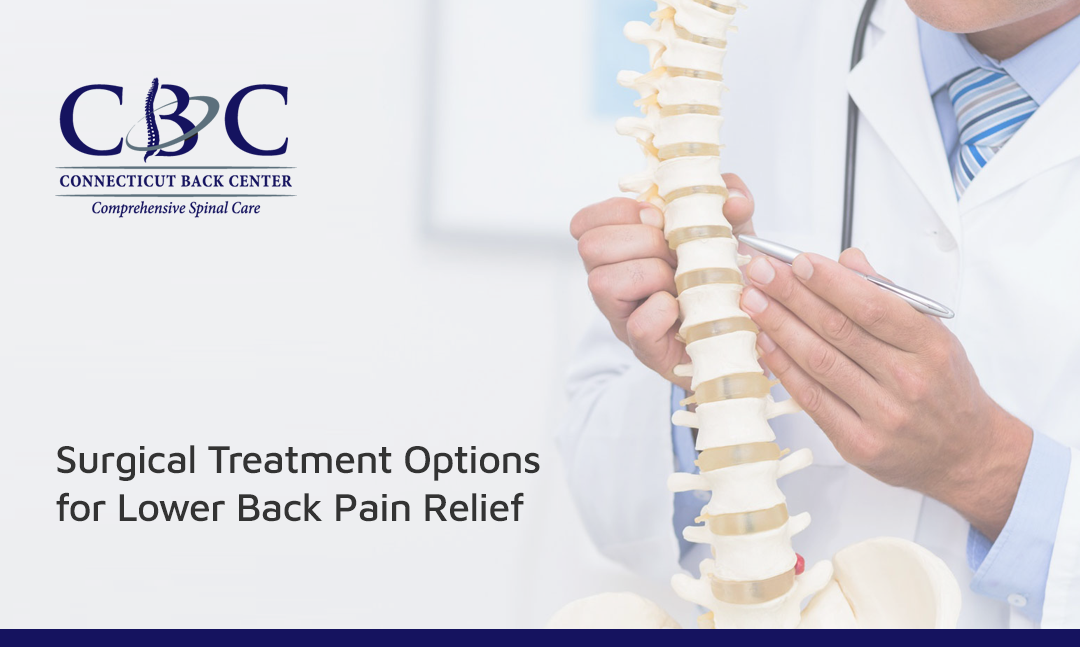When conservative treatments do not resolve your lower back pain, your specialist may recommend surgery to help alleviate your lower back pain. Recommended surgical treatment will depend on your individual situation. Below outlines several of the lower back pain surgeries commonly performed by the surgeons at Connecticut Back Center.
- Lumbar Laminectomy
- Lumbar Microdiscectomy
- Spinal Fusion
- Interbody Fusion
- Interbody Fusion with Cages
Lumbar Laminectomy
Lumbar laminectomy is a procedure that involves removing bone to relieve excess pressure on the spinal nerve(s) in the lower back or lumbar spine. Laminectomy removes the roof of the vertebrae to allow space for nerves exiting the spine. A lumbar laminectomy can relieve chronic lower back pain and leg pain that radiates. Learn More: Lumbar Laminectomy
Lumbar Microdiscectomy
When you herniate an intervertebral disc, you may have pain in your lower back (lumbar spine) and legs, among other symptoms of a “pinched” adjacent nerve root.
Spine surgery for lumbar disc herniation is performed using a microscope and microsurgical techniques. Thanks to its magnification and illumination, the surgical microscope facilitates limited dissections. We only remove that portion of the herniated disc that is pinching nerve roots. Any pressure placed by a herniated disc on nerve roots can cause symptoms such as debilitating leg pain and weakness or numbness in your feet and legs. You may also experience bowel or bladder incontinence. If your symptoms are due to a pinched nerve you may be a candidate for microdiscectomy. Learn More: Lumbar Microdiscectomy
Spinal Fusion
The spinal fusion procedure involves placing bone grafts between adjacent spinal vertebrae to join the two structures together. When appropriate, we may use minimally invasive surgical techniques. If the vertebrae are fused together they stop rubbing against each other. By placing bone grafts or bone substitutes between the affected bones, graft material helps maintain normal disc height. During healing, the bone and bone graft can grow together and stabilize your spine. Learn More: Spinal Fusion
Interbody Fusion
Interbody fusion means uniting two bony segments, whether due to a fracture or a vertebral joint issue. Typically within four months, the bone grafts will unite the vertebrae above and below to form one piece of bone. The reasons for performing interbody fusion are to: Remove the degenerative disc, Separate the two vertebral bodies, as they were before the disc degenerated, Keep them in that position by interposing several pegs of bone (bone graft). Learn More: Interbody Fusion
Interbody Fusion with Cages
Interbody fusion using cages was designed as a less invasive method for achieving spinal fusion. This procedure opens the collapsed nerve canal and lifts pressure away from pinched nerve roots. A bone graft will grow through and around the implants, forming a bone bridge that connects the vertebral bodies above and below. Learn More: Interbody Spinal Fusion with Cages
If you are one of the many people suffering from neck pain, chronic lower back pain, scoliosis, sciatica or another spine-related condition, you will be in great hands at Connecticut Back Center (CBC). CBC was founded by Jesse Eisler, MD, PhD, in 2005 and with offices in Vernon and Bloomfield, CT serves the Greater Hartford and Central Connecticut area. Our mission is to provide accurate, responsive and effective spinal care with comprehensive non-surgical and surgical treatments for the full spectrum of spinal disorders. Our goal is always to reduce your pain, increase your flexibility and help you resume an active life after treatment. To learn more about your treatment options, give us a call at (860) 253-2714 or request an appointment online now.

